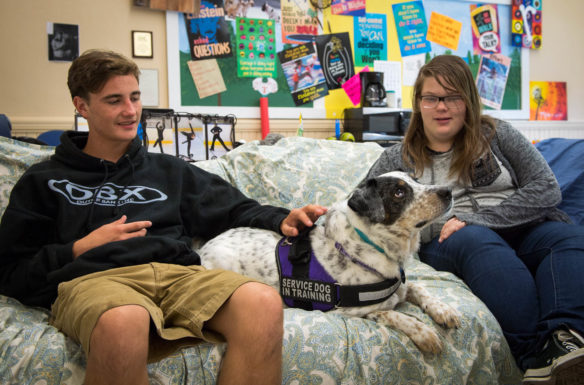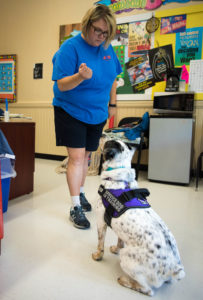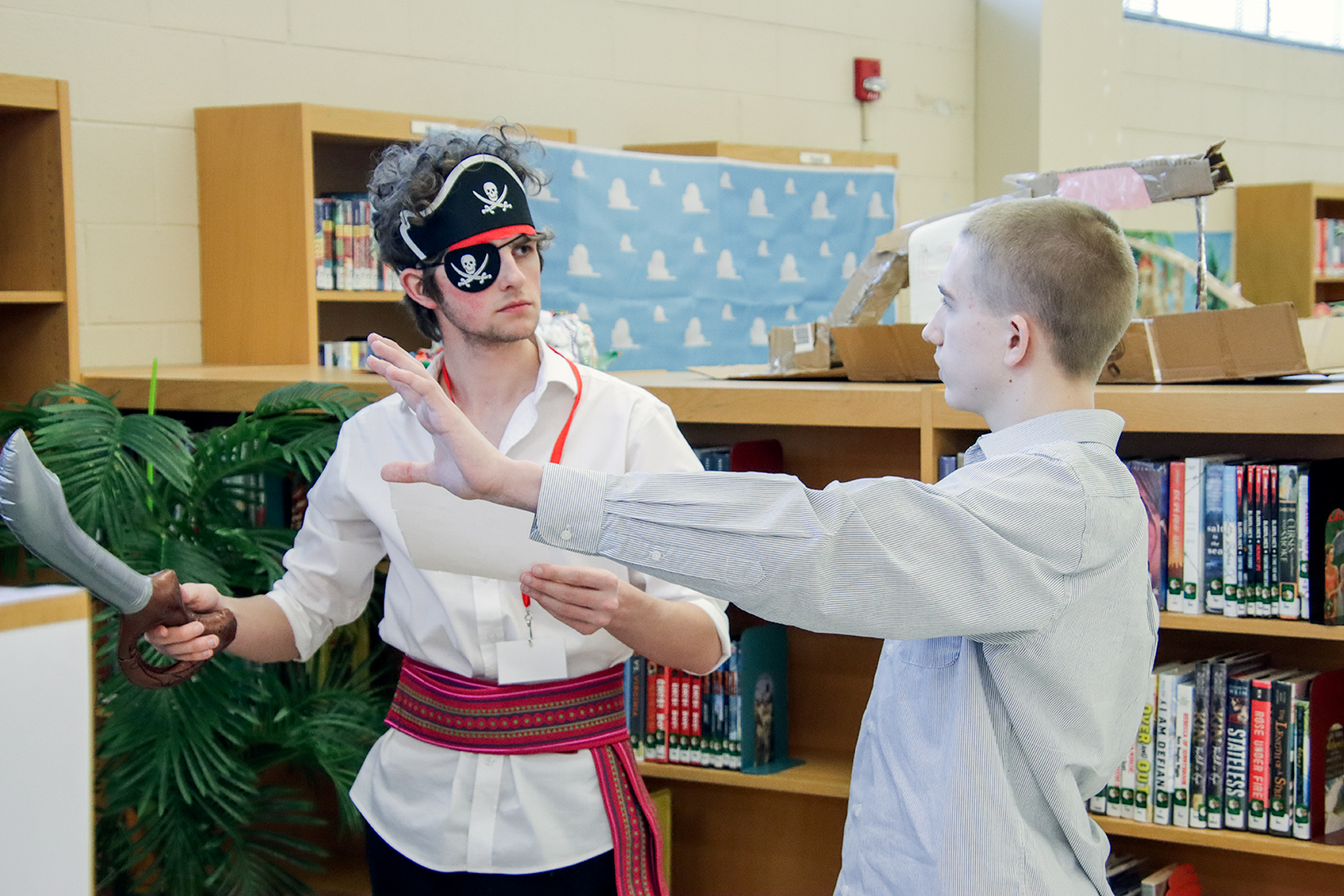
Jarred Moore, left, and Dakota Washington, both 9th-grade students at The Providence School (Jessamine County), pet Kompass, a therapy dog used at the school. Kompass is one of two therapy dogs that interact with students at The Providence School, one of 11 Alternative Programs of Distinction recognized by the Kentucky Department of Education earlier this year.
Photo by Bobby Ellis, Aug. 18, 2017
By Mike Marsee
michael.marsee@education.ky.gov
Not every agent of change in a school has to be human.
At The Providence School (TPS), an alternative school in Jessamine County, two dogs are helping faculty members keep their students on track to graduation.
Erik and Kompass, a pair of therapy dogs who came to the school this winter, have helped students who weren’t always willing to communicate more freely.
“They changed our school almost from the moment they were brought in,” said Eric Sowers, who was the school’s assistant principal last year and will be its principal this year.
The addition of the therapy dogs is one of the things TPS did to earn recognition by the Kentucky Department of Education (KDE) as one of 11 Alternative Programs of Distinction.
“There are many ways in which alternative programs can succeed,” said Sherri Clusky, a program consultant with KDE’s Division of Student Success. “These schools are tremendous examples of what can be done to make sure that alternative programs give their students a quality education.”
Here are examples of how two alternative schools are succeeding:
Animals among the key players at Jessamine school
Erik and Kompass, the therapy dogs, came to TPS in February as a result of the work of counselor Regina Spencer, who brought the idea to the school board and takes care of the dogs at her own expense.

Regina Spencer, the day treatment counselor at The Providence School (Jessamine County), works with Kompass, a therapy dog. Spencer takes care of Kompass and fellow therapy dog Erik at her own expense and brings them to school each day.
Photo by Bobby Ellis, Aug. 18, 2017
Spencer brings the dogs to the Wilmore school each day, and students are happy to pet, help train or just spend time with them. Perhaps more importantly, Spencer makes the dogs available at any time during the day for students who need to talk.
“We saw some pretty big therapy gains for students that we had struggled to make progress with,” Sowers said. “It’s really allowed some of them to open up.”
Other animals also serve students at TPS. The school offers a class in conjunction with nearby Asbury University in which students get to interact with and learn about horses. Students in the class visit Asbury’s equine center, where they observe the horses’ behavior and body language to determine their mood. They also learn how to make the horses obey through their own actions in what Sowers said is the only therapeutic equine class in Kentucky being offered for high school credit.
Sowers said TPS’ approach to teaching and learning is based on two foundational principles:
- the Discovery program, called “the toolbox” of the school, which is a student-centered, skills-based program designed to teach students positive social skills. It includes a classroom management system that provides consistency in the way staff members relate to students and hold students accountable.
- vision-driven learning that allows students to pursue a “life vision,” and accomplish personal goals. Created at the middle school level in 2011 and later expanded to the high school, it allows students to envision a better future for themselves and creates a project-based learning experience to match their vision.
“We have an approach to teaching and learning that is truly alternative,” Sowers said.
TPS students also have other opportunities that aren’t always available at alternative schools. The list of extracurricular activities includes archery. A West Jessamine High School archery team that competed in the National Archery in the Schools Program World Tournament last month included some TPS students.
“I can’t tell you how successful that program has been,” Sowers said.
There is also weightlifting – used as a way to incorporate elements of physical education – recreational basketball, a music club and a cooking club.
“At least once a month, we have an after-school activity for the entire school,” Sowers said.
In addition, students can walk to the Asbury campus just a couple of blocks away to take dual-credit courses.
TPS serves about 160 students in grades 6-12.
Daviess changes its approach to alternative education
It took less than two years for Heritage Park High School to reinvent alternative education in Daviess County.
Heritage Park opened in August 2015 to replace Beacon Central High School, a school that focused primarily on credit recovery.
“The school board and the district said, ‘We can be more than this, and this is our opportunity,'” Heritage Park Principal Michelle Ruckdeschel said. “We’re trying to change the perception of what an alternative school is. We’re not a school for bad kids. This is a school that reaches kids where they are and meets their needs in a different way.”
Community involvement is a key to doing that, said Ruckdeschel. The school made community outreach a part of its program, with students at each grade level getting two opportunities each year to develop a project – such as working with a local homeless shelter, spending time with residents at an assisted living center across the street from the school or reading Dr. Seuss books to elementary school students.
“Going into those schools to read was scary for some of our 12th-graders, but the kids loved them so much we couldn’t hardly get them back on the bus,” said Ruckdeschel, who has been the principal at Heritage Park since it was founded.
There is an emphasis on project-based learning, which has led to student-created publications, forensic science projects and other endeavors. For example, students who were in the 11th grade last year completed a project in which they researched the history of Owensboro and Daviess County.
Seniors also have opportunities for co-op employment, and juniors participate in a job-shadowing program in which they study a potential employer from the inside once each quarter.
“We have a different approach to learning,” Ruckdeschel said students’ grades typically rise after moving to Heritage Park, and there are other indicators of the school’s success as well.
“We are seeing the beginning of an upward trend in the ACT scores of our students. We also are beginning to get more of our seniors on campus taking college courses for dual credit, and we are seeing more of our students entering jobs that can become sustainable careers,” she said. “Our students are also learning to advocate for themselves. Several students have said that they are less anxious in this setting, and that they are making better decisions.”
Heritage Park serves about 180 students in grades 10-12.
MORE INFO …
Eric Sowers eric.sowers@jessamine.kyschools.us
Michelle Ruckdeschel michelle.ruckdeschel@daviess.kyschools.us
Sherri Clusky sherri.clusky@education.ky.gov




Leave A Comment